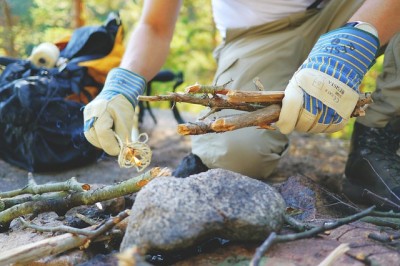If you find yourself in a survival situation in the woods, you’re basically standing in a goldmine of potential resources, all of which are literally at your fingertips along the trunks of nearby trees. Knowing just how versatile tree bark can be might just save your life.
1. Cordage
Tree bark, specifically long strips of inner bark, can be wrapped or braided together to create durable and flexible cordage quickly. Simply cut away the flaky outer bark from a section of the tree, and then begin to peel the inner bark away in long strips. Don’t remove more than one-fourth of the bark around the tree, or the tree might not be able to survive. Longer cuts top to bottom are better than wider cuts going further around the tree.
Good tree species to try include cedar, aspen, basswood/linden, maple or willow.
2. Food
While eating tree bark may seem to be an act of desperation, it’s actually a traditional food in some cultures, eaten for its distinctive flavor even in times of plenty. The indigenous Sami people of northern Sweden use the inner bark of birch trees, first drying and then grinding it into a flour for baked goods. It’s described as giving a “sweet woody aroma” to baked goods, and actually boasts 1,000-1,200 calories per kilogram.
Get The Essential Secrets Of The Top Survivalists In The World!
Pine bark is also used by northern Scandinavian people for food, and rather than being relegated to a famine food, there is historical evidence that rich, well-off families collected the largest amounts of the nutrient rich inner bark. While it is also commonly ground into flour, it can be eaten fresh during harvest and has a mild sweetness and texture similar to coconut meat. As an added bonus, it contains plenty of vitamin C to help ward off scurvy during the wintertime.
3. Medicine
While the medicinal properties of willow bark, the native source of Tylenol, are well-known, there are many other tree species that also have medicinal bark.
Witch hazel extract is an antibacterial wash made by cooking thin witch hazel branches on a slow simmer for many hours to extract the compounds in the wood and bark.
Beech bark tea is used to treat lung problems and was once used to treat illnesses as significant as tuberculosis. Even common apple tree bark has medicinal properties when used to treat fevers and diarrhea. For a more comprehensive list of medicinal tree bark, take a look at 10 Medicinal Trees that Heal Virtually Everything.
4. Basketry
The inner bark of basswood, elm, hickory, willow, ash and maple trees all can be used to weave sturdy and long-lasting basketry. Strip off the outer bark, and then peel the inner bark into long flexible strips. Roll up the bark strips for storage until you’re ready to begin working, and then rehydrate them with warm water to make them more workable before beginning to weave your basket.
5. Fire-starting
Most devoted campers know that the outer bark from birch trees makes excellent fire-starting material. It peels easily from the trees without harming them and is full of flammable resin that ignites easily. Pine bark from dead pine trees also makes great tinder because of its flammable resin.
6. Cooking
Tree bark, especially from trees with flexible bark that comes off in large sheets, can be formed into cooking vessels and used to make just about any food you want. Well-moistened birch bark sheets can be used to create an impromptu wok for cooking over hot coals. Let the fire burn down to a thick layer of very hot coals, and then cover with ash to create a barrier. Place the well-moistened birch bark on top and cook your food on the clean hot surface.
Tree bark containers also were traditionally used for boiling maple sap into syrup, as well as storing the finished maple syrup for long periods of time (up to a year).
7. Bedding
In a survival situation, it’s essential to insulate yourself from the cold ground while sleeping to prevent hypothermia, even in relatively mild climates. Tree bark is an excellent insulator because it can be peeled in large sheets that can be flattened to create a smooth and comfortable surface. The corky nature of many species of bark also creates a natural insulation.
Do you know of other survival uses of tree bark? Share your tips in the section below:
Learn How To ‘Live Off The Land’ With Just Your Gun. Read More Here.
 Off The Grid News Better Ideas For Off The Grid Living
Off The Grid News Better Ideas For Off The Grid Living





